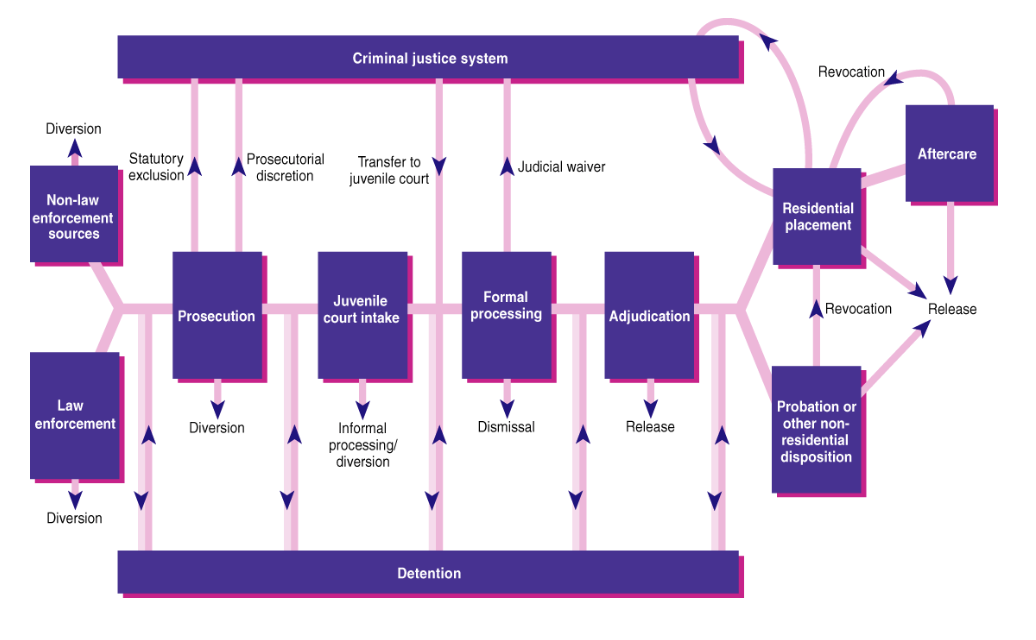10.10. The Structure of the Juvenile Justice System
Alison S. Burke
The juvenile justice process involves nine major decision points: (1) arrest, (2) referral to court, (3) diversion, (4) secure detention, (5) judicial waiver to adult criminal court, (6) case petitioning, (7) delinquency finding/adjudication, (8) probation, and (9) residential placement, including confinement in a secure correctional facility (see Juvenile Justice Process flow chart). [1]
The majority of cases are first referred to the juvenile justice system through contact with police. Probation officers, school officials, or parents usually refer to the remaining cases. The most common offenses referred to court are property offenses (roughly 92%), followed by person offenses (89.5%), drugs (88.2%), and general delinquency charges (81.6%). Other referrals come from schools, families, social workers, or probation officers.
At the intake stage, probation officers or attorneys determine whether or not the case needs the attention of the juvenile court or if it can be handled informally, such as diversion to probation or a drug treatment program. If the case progresses to court, the authorities need to determine if the youth can be released to a parent/guardian or if the youth needs to be held in a secure detention center. When determining this, the court needs to assess the risk the youth poses to society and if the youth poses a flight risk. In some cases, the parent cannot be located or, if located, refuses to take custody of the youth. In these cases, the juvenile is remanded to custody. The decision to detain or release the juvenile will be made by the judge at a detention hearing.
If the case is handled in court, the county attorney needs to file a petition. When the youth has a formal hearing, it is called an adjudication rather than a trial in adult court. The adjudication of youth as delinquent can result in either dismissal of the charges or confinement at a secure institution. In most juvenile cases, the least restrictive option is usually sought, so the youth is usually put on probation or some sort of community treatment. Formal processing is less common than informal processing involving diversion or community-based programming.

Working With Youth
When I graduated from college with a BA in psychology, I applied for a job working with the Division of Youth Corrections in Denver, CO. I worked in a Residential Treatment Facility (RTC), which used behavior modification techniques, assigned case workers to each youth and their families, and attempted to help the kids learn problem-solving skills and accountability. Youths were confined for a variety of reasons, from committing gang-affiliated drive-by shootings to youth who were designated dependent youth through social services and having nowhere else to go. We had high-risk kids, low-risk kids, conduct disorder, and mental health kids all together in the same unit. Having a mix of all these different kids is not a great formula; the low-risk kids learn negative behavior from the high-risk kids, and the conduct disorder kids victimize the mentally healthy kids. In an ideal institution, these different populations would all be in separate units.
Working with youth is hard. They push boundaries, are angry, try to manipulate those around them, and reject authority. However, working with youth is exceptionally rewarding. They are kids. They come from abusive and neglectful homes and are yearning for approval and love. For example, one boy in our facility was named Josh. He was a super angry and violent sixteen-year-old who was sentenced for committing aggravated assault. Through working with counselors and caseworkers, we discovered his anger was hiding immense sadness. He lashed out at those around him when he was sad because he had no way to show his feelings other than through aggression. Many months of working with him, encouraging him to journal, express his feelings, talk with others, and use other tools to help him with his sadness led to amazing results. He left our facility after more than a year, graduated from high school, and even went to college! Getting the individualized attention helped Josh change. He became a success story in the juvenile justice system.
Working with youth takes patience, consistency, and compassion. It is one of the most difficult jobs there is, but it is possible to be a very positive influence in the lives of kids who need it the most. If you are interested in working with youth, plan on committing to at least a year. Incarcerated kids are used to having people give up on them and disappoint them, so you do not want to add to their negative experiences. Show up, follow through, and be optimistic about a better future for justice-involved youth.
- Sickmund, M., & Puzzanchera, C. (2014). Juvenile offenders and victims: 2014 national report. ↵

